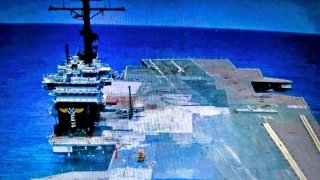USS America: Why the Navy Failed to Sink Its Own Aircraft Carrier
Since the USS America had such an honorable track record at sea, the Navy decided to make one last use of the carrier.
How USS America Died: The intentional scuttling of the USS America proved that sinking a carrier is easier said than done. On May 14, 2005, the Kitty Hawk-class supercarrier sank 17,000 feet below the floor of the Atlantic Ocean after weeks of controlled explosions.
Before this incident, World War II had been the last time any military permanently sank a U.S. Navy aircraft carrier.
Shortly following the carrier’s scuttling, the Naval Sea Systems Command released a statement clarifying that “the data collected during the 25 days at sea from [the USS America’s] test events will be of great value to Navy engineers and designers to improve the design and survivability of the nation’s future aircraft carrier fleet.”
In other words, the USS America’s exit was honorable and morbid simultaneously.
A Brief Overview of the Kitty Hawk Class Carrier
After World War II, America prioritized building a fleet of nuclear-powered aircraft carriers. A project dubbed SCB 160 was designed to conceptualize and manufacture these vessels, but ultimately the plan to produce six nuclear-powered carriers was nixed due to high construction costs.
The first ship in the Enterprise class of nuclear carriers was reordered as a conventionally-powered Kitty Hawk-class carrier and given the name USS America. By 1961, the new supercarrier was laid down and eventually launched three years later from the Norfolk Naval Shipyard.
The USS America (CV-66) joined the Constellation (CV-65), the Kitty Hawk (CV-63), and the John F. Kennedy (CV-67) to replace the aging Forrestal-class vessels. Measuring at roughly 1,050 feet long with a 248-foot beam, the USS America was a truly massive vessel.
Over 4,500 personnel were required to operate the carrier, which could reach up to 34 knots and carry around 80 airframes. The USS America was also the first carrier to possess a sonar system.
Deployment Timeline
America set sail on its first deployment in the mid-1960s. The vessel passed through Cannes, Toulon, Athens, Istanbul, Beirut, and Spain. The supercarrier ended its premiere deployment by participating in a stimulated conventional warfare drill with France dubbed Fairgame IV.

The USS America was deployed to the Pacific three times during the Vietnam War. When the large supercarrier was not deployed, it mostly loitered in the Mediterranean and the Atlantic.
Although newer and more advanced carriers emerged by the 1990s, the USS America was expected to undergo a Service Life Extension Program in lieu of being decommissioned. Sadly, budget cuts forced the Navy to retire the large vessel.
One Last Task for the USS America
Since the USS America had such an honorable track record at sea, the Navy decided to make one last use of the carrier. After being towed hundreds of miles to a location off the Virginia coast, the former carrier prepared to be scuttled for data purposes.
As explained by then-Vice Chief of Naval Operations Adm. John Natham, “America will make one final and vital contribution to our national defense, this time as a live-fire test and evaluation platform.

America's legacy will serve as a footprint in the design of future carriers — ships that will protect the sons, daughters, grandchildren and great-grandchildren of America veterans.” The results of the SINKEX drills remain classified, as do detailed imagery or videos of the operation - accept for one image, posted above.
As one expert noted, sinking the vessel was a challenging ordeal. “It took four weeks and they ended up having to scuttle her from on board due to her not sinking. She is not only far larger than WWII battleships, but she is also a lot tougher. While she does not have the heavy armor the battleships of yore had, she does have a double layered hull, meaning weapons have to push through alternating layers of steel and empty pockets to reach her internals.
“On top of that, her internal compartmentalization was far better than that of battleships. She is so large, there are so many more rooms that must be filled in order to make her sink than that of a battleship.
Maya Carlin is an analyst with the Center for Security Policy and a former Anna Sobol Levy Fellow at IDC Herzliya in Israel. She has by-lines in many publications, including The National Interest, Jerusalem Post, and Times of Israel.


